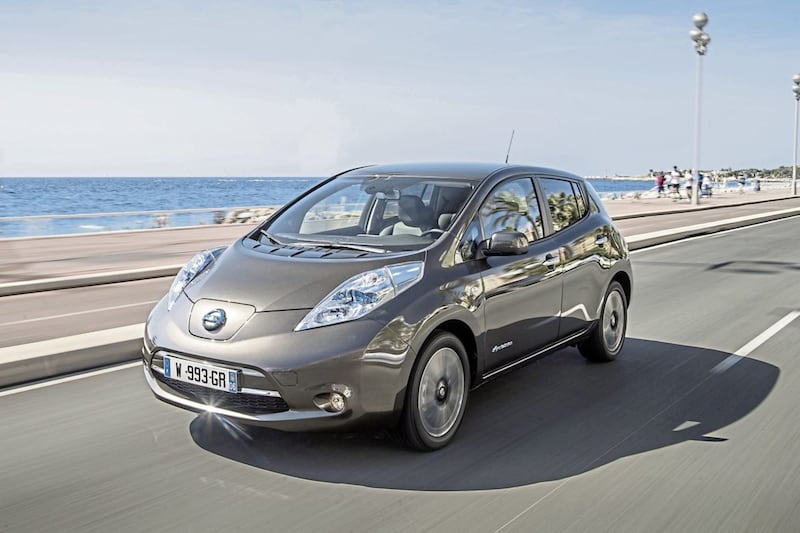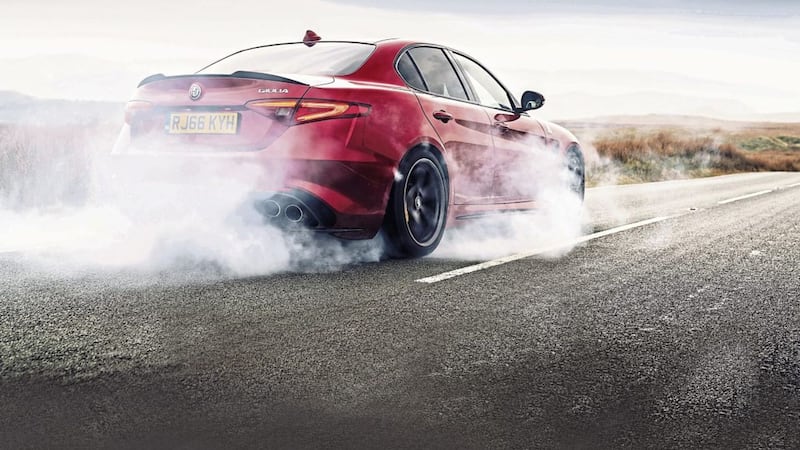LAST week I drove something called an Alfa Romeo Giulia Quadrifoglio.
Sounds good, doesn't it? You can tell from the name alone that it's going to be fast and sexy, a bit unruly and ready to show you a good time.
And that's before you get as far as thumbing the rossa corsa start button - it's on the steering wheel, just like you get in a Ferrari - and firing up its engine.
It has a twin-turbo V6 petrol-fuelled weapon under the bonnet, and it wakens from its slumber with a Cerberus-bark.
The Quadrifoglio, a blood red cruise missile rolling on 19-inch alloys, can blat down the road faster than one of Jove's thunderbolts
Visceral, responsive, thrilling; the Quadrifoglio is peak petrol car, evidence of the heights the internal combustion engine has scaled since Karl Benz and Gottlieb Daimler invented the automobile 130 years ago.
Nearly everything sounds better in Italian. "Quadrifoglio" means "four-leaf clover", and relates to an emblem which has been part of Alfa Romeo's sporting heritage since 1923.
But not all leaves are created equal. The Quadrifoglio is a million miles away from the Nissan Leaf. Both have four wheels, some doors and 'leaf' in their names, but that is where the similarities end.
I find it hard to imagine that anyone has ever woken up in the morning and decided that they simply must have a Nissan Leaf in their lives; where 'Alfa Romeo Giulia Quadrifoglio' speaks of desire, 'Nissan Leaf' sounds dangerously close to despair. Or a stifled yawn.
However, because it is an electric vehicle powered by its own batteries, the government would like us all to be driving cars like the Nissan Yawn - and the sooner the better.
It took time out from mucking up the Brexit negotiations to announce this week that the sale of new petrol and diesel cars would be banned from 2040.
'Alfa Romeo Giulia Quadrifoglio' speaks of desire, but 'Nissan Leaf' sounds dangerously close to despair
The move comes at a time of febrile debate over the future of the car, with the internal combustion engine being blamed for global warming, ill health and even premature death.
Diesel has come in for a particularly hard time, not least because the German giant Volkswagen was caught cheating in emissions tests.
Petrol and diesel engines have never been more efficient or cleaner, but it has been clear for some time that political will and public opinion is travelling in the direction of electric cars.
Electric vehicles - EVs in the shorthand of the industry and early adopters - have many real benefits.
Because they have no noisy engine, they are quiet. They are smooth and easy to drive, and designers are able to use the space liberated by the absence of a bulky engine and gearbox to make more comfortable and spacious cabins.
EVs are also cheap to run, at least for now. The electric needed to recharge the battery is cheaper than a tank of diesel or unleaded, and they are favoured by the current car tax and benefit in kind rates.
They can even be good to drive, if not in the Giulia Quadrifoglio league. BMW's i3 is a lovely car to drive, and US EV-maker Tesla has in just a few years already carved a niche as a purveyor of very quick cars with decent range.
The absence of exhaust emissions is another major benefit, though this has to be balanced against the fact that the electricity that EVs consume has to be generated elsewhere.
This is where deep difficulties lie in the EV quest. It is estimated that 250 billion passenger car miles are travelled each year in the UK, and that the power needed to meet than demand would represent 20 per cent of existing annual electricity production.
Can the electricity grid cope? How - and where - is the extra energy to come from?
We live in a part of the world where the north-south interconnector has been mired in a planning quagmire for eight years, and counting. Is Northern Ireland really ready for an infrastructure project as demanding as that needed for an EV future?
The speed at which EV batteries can be charged is increasing all the time, but this puts even more strain on electricity distribution.
While many people should be able to install a charging point at their home, what of those who have no reliable parking space?
A network of extensive - and expensive - public charging points will be needed.
It is easy to imagine how today's petrol stations might be replaced with charging stations, but these will need an enormous amount of electricity. Today, Tesla's 'superchargers' are regarded by many as the gold standard but at full tilt these use as much power as more than 100 homes...
Which brings us back to electricity generation and its distribution - and who is going to pay for it all.
You and I will, of course - and quickly.
The government has already indicated that it is going to tax diesel cars harder to help finance the transition to an EV future.
It seems likely that the government will also have to bankroll or at least underwrite the private investment needed to meet the challenge.
That work will need to start soon, particularly given the booby-traps that seem to afflict and string-out every major infrastructure project in Northern Ireland.
In the meantime, enjoy cars like the Alfa Romeo Giulia Quadrifoglio while you still can...










